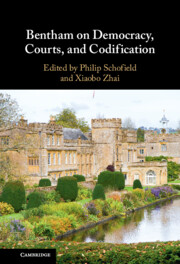Book contents
- Bentham on Democracy, Courts, and Codification
- Bentham on Democracy, Courts, and Codification
- Copyright page
- Contents
- Contributors
- Introduction
- Part I Democracy
- 1 Intellectual Aptitude and the General Interest in Bentham’s Democratic Thought
- 2 Bentham, Democracy, Free Government, and the Relationship between Rulers and Ruled
- 3 The Interests of Women in Bentham’s Late Constitutional Thought
- 4 Religion and Judgement in Bentham’s Political Thought
- 5 Organizing the Utilitarian State
- 6 Bentham on the Corruption of Democracy
- 7 The People’s ‘Greatest Misfortune’ and ‘All the Chance the People Have’
- Part II Law and the Courts
- Part III Codification
- Bibliography
- Index
2 - Bentham, Democracy, Free Government, and the Relationship between Rulers and Ruled
from Part I - Democracy
Published online by Cambridge University Press: 25 August 2022
- Bentham on Democracy, Courts, and Codification
- Bentham on Democracy, Courts, and Codification
- Copyright page
- Contents
- Contributors
- Introduction
- Part I Democracy
- 1 Intellectual Aptitude and the General Interest in Bentham’s Democratic Thought
- 2 Bentham, Democracy, Free Government, and the Relationship between Rulers and Ruled
- 3 The Interests of Women in Bentham’s Late Constitutional Thought
- 4 Religion and Judgement in Bentham’s Political Thought
- 5 Organizing the Utilitarian State
- 6 Bentham on the Corruption of Democracy
- 7 The People’s ‘Greatest Misfortune’ and ‘All the Chance the People Have’
- Part II Law and the Courts
- Part III Codification
- Bibliography
- Index
Summary
Jeremy Bentham wrote both these passages, although eighteen years separated them. The first, praising the Seditious Meetings Act of 1795, which banned large political meetings unless licensed by a magistrate, appears in Bentham’s little-known writings of 1798–9 on preventive police.3 The second, in critique of both the Seditious Meetings Act of 1817, which repeated the provisions of the Act of 1795 and added new penalties, and the suspension of habeas corpus, appears in the work by publication of which, eight years after initial drafting, Bentham declared himself a proponent of radical parliamentary reform. How is the contradiction to be explained, or how did the Bentham of 1799 come to view draconian restraints on liberty of association as a guarantor of security, when at all other times he viewed that liberty as a crucial characteristic of free governments? An examination of Bentham’s attitude to democracy sheds light upon this question and on ambiguities and developments in Bentham’s thinking about the exercise of political power and the appropriate means for its control.
- Type
- Chapter
- Information
- Bentham on Democracy, Courts, and Codification , pp. 44 - 67Publisher: Cambridge University PressPrint publication year: 2022



